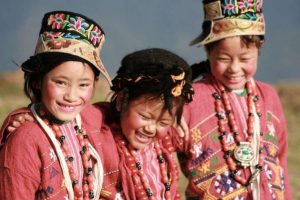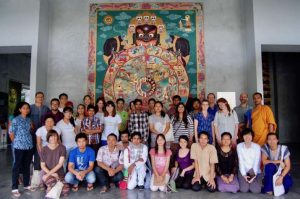The fact that thousands of dalits are embracing Buddhism is great news for any lover of non-violence, and for the Buddhist community in particular. It reaffirms the idea that Buddhism is the last refuge for the downtrodden, which marks out this religion for eager embrace by sufferers of injustice. Besides its ethical teachings, the lofty philosophical foundations of Buddhism have caught the attention of many people of different faiths, ranging from the eminent scientist Einstein (a Jew) to a lay Hindu like myself. The Buddhist community probably can’t imagine the number of their secret admirers across the world!
Buddhism is a religion which, as my limited knowledge goes, always speaks against desire and abhorrence as well as violence. In the context of the dalits’ embrace of Buddhism, perhaps many harbored a degree of hatred toward their own religion and shifted to Buddhism in the hopes of a better life. Unfortunately, if they hadn’t let go of the taints of hatred and desire before converting to another religious faith, they would have disobeyed one of the basic teachings of Buddhism: non-hatred. That is, it is extremely dangerous to convert to another faith because of hatred for another, even if the latter is seen as an instrument of social and economic oppression.
The literal meaning of the term ‘dalit’ is ‘downtrodden’ or ‘unprivileged’. And it is difficult or even futile to find any reference to it in the Hindu scriptures. The Varna dharma, which is believed to be the root of the caste system, states that functions were decentralized among the members of society according to their quality and aptitude. The purpose of Varna dharma is to organize a society where each individual can secure his position in society for which he is best fitted. Varna dharma emphasizes the groups of people that exist in society, not how society should be classified into hierarchical classes.
Based on the functions performed by the members of a society, there are four varnas — Brahmin, Kshatriya, Baishya and Shudra. Brahmins are entrusted with the functions of learning, sharing and preserving the knowledge (particularly of the Veda); Kshatriyas, the martial class, defend and administer society; Baishyas, the productive class, look after trade and business; and Shudras, the artisan class, cover most of the occupations.
Traditional dharma states that one can attain spiritual realization/ liberation provided he properly performs his function, regardless of which varna he belongs to. “Svadharme nidhanam shreyah, paradharmo bhayavaha” (Bhagavad Gita: 3:35). That is, better is death in one’s own duty; the duty of another is fraught with fear. Sadly, these ancient professional social classes have been replaced by castes by birth with its accompanying evils, viz., hatred, enmity, jealousy and discrimination etc. So we have now a hierarchical caste system with the Brahmin at the apex and Shudra at the base, which in the strictest sense does not have any scriptural support.
Hence so far as varna dharma is concerned, we cannot define dalit within the framework of Hinduism. It rather owes its origin to our beliefs and probably it is an issue which can better be addressed from individuals’ economic and political conditions. A dalit is one who is economically hobbled and dispossessed of political power. In that sense, it will exclude many dalits who are far beyond being neglected by the so-called upper classes and include many lowly upper classes who are living more wretchedly than the so called dalits. The Indians have witnessed politicians whose luxurious living, despite being a dalit, posed the question of whether the leader could be called a “true” dalit.
Similarly, even against our common belief about the upper caste as the most privileged, the sad truth is that their high caste sometimes hinders them from accessing the benefits offered by the Government. The irony is that the Brahmin is forbidden from adopting certain occupations like tilling lands, fishing etc. Is his priestly position enough to meet his basic needs? The caste system does not only affect the lower castes but also the upper castes.
Keeping in mind the current scenario of Indian society, either dalit is a very vague term, or it is wide enough to embrace all the disadvantaged regardless of their castes. It does not seem fair to make our religion solely responsible for our plight. From the Buddhist point of view, it would be impossible to think of the removal of suffering without properly identifying the cause.






Facing every challenge valiantly helps to ease our conscience even if we fail to overcome the challenge. The Buddha himself asked us to live out every moment, be it pleasant or unpleasant. One of India’s iconic teachers, Swami Vivekananda said: ‘If you ever feel afraid of anything, always turn round and face it. Never think of running away.’ There is a story behind this great teaching. Once at Varanasi, as Swamiji was coming out of the temple of Mother Durga, he was surrounded by a troop of chattering monkeys. He started to run away, as he did not want them to catch hold of him. Then an old monk called out to Swamiji to stop and face the monkeys. As he turned around and faced the monkeys, they ran away.
Can converting to Buddhism really ensure the complete end of dalit suffering? Few honest Buddhists would insist that they themselves are free. Put more uncomfortably, how can a spiritual reorientation change economic misfortunes? These are all practical questions that need to be asked in light of the apparently considerable numbers of new dalit converts to Buddhism, to ensure that they are able to enjoy a truly authentic spirituality and address their economic grievances.
Nevertheless, it is encouraging to see that the dalits have taken refuge in Buddhism, whose end is peace, means is non-violence, and stepping-stone is suffering. I’m confident that they will be able to perceive, comprehend, and identify the causes and solutions to their suffering in the light of the Buddha’s great teachings.











